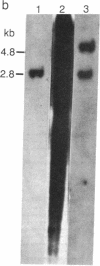Abstract
CR1 is a short interspersed repetitive DNA element originally identified in the domestic chicken (Gallus gallus). However, unlike virtually all other such sequences described to date, CR1 is not confined to one or a few closely related species. It is probably a ubiquitous component of the avian genome, having been detected in representatives of nine orders encompassing a wide spectrum of the class Aves. This identification was made possible by using the polymerase chain reaction (PCR), which revealed interspecific similarities not detected by conventional Southern analysis. DNA sequence comparisons between a CR1 element isolated from a sarus crane (Grus antigone) and those isolated from an emu (Dromaius novaehollandiae) showed that two short highly conserved regions are present. These are included within two regions previously characterized in the CR1 units of domestic fowl. One of these behaves as a transcriptional silencer and the other is a binding site for a nuclear protein. Our observations suggest that CR1 has evolved under functional constraints and that interspersed repetitive sequences as a class may constitute a more significant component of the eukaryotic genome than is generally acknowledged.
Full text
PDF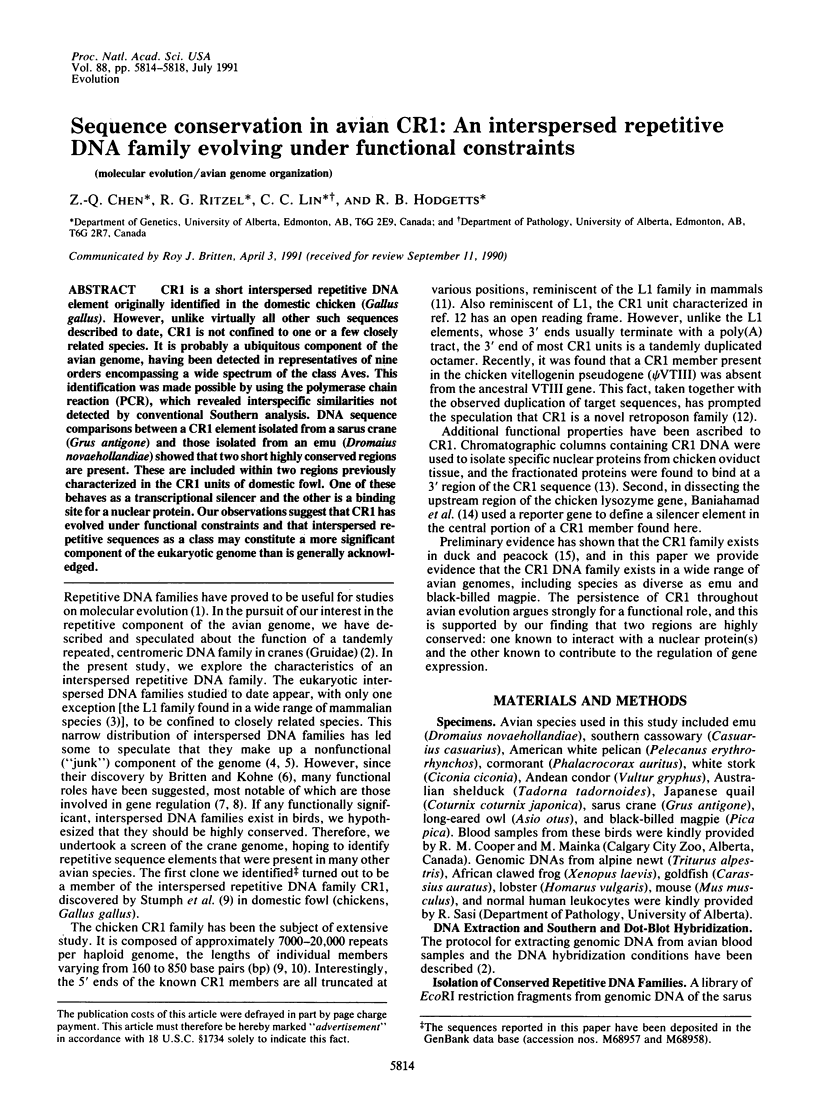
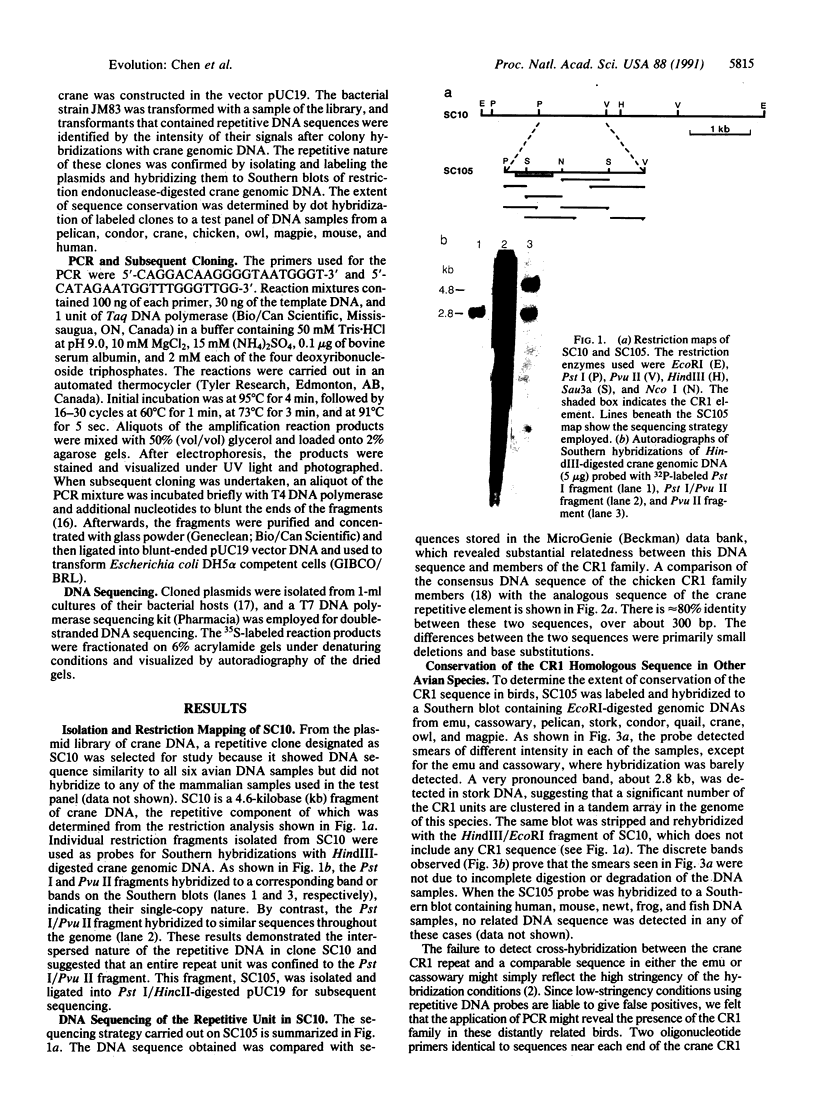
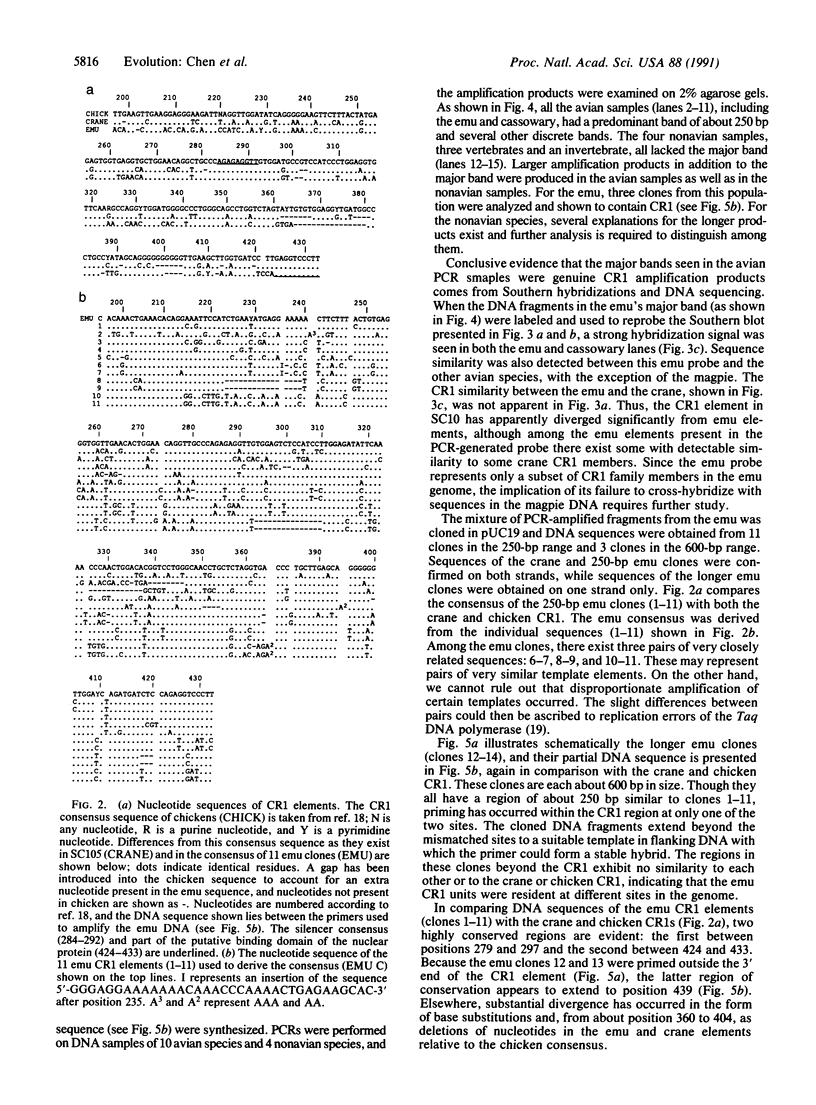
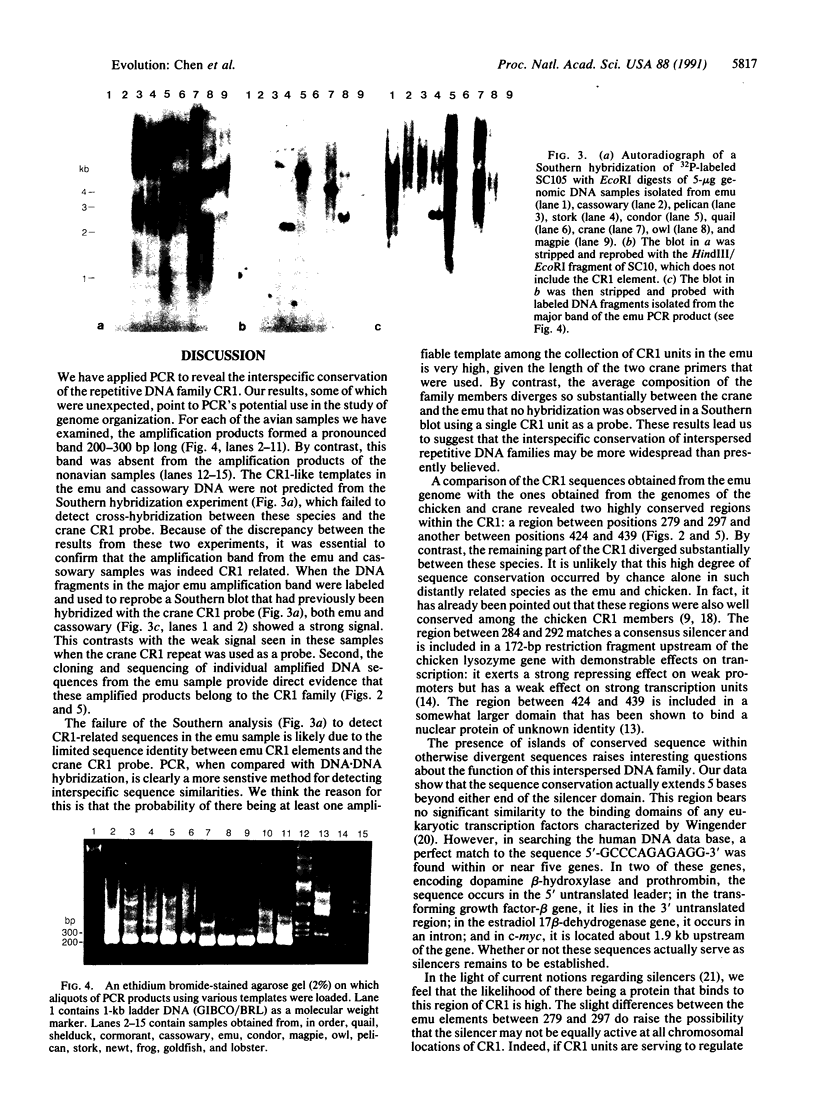
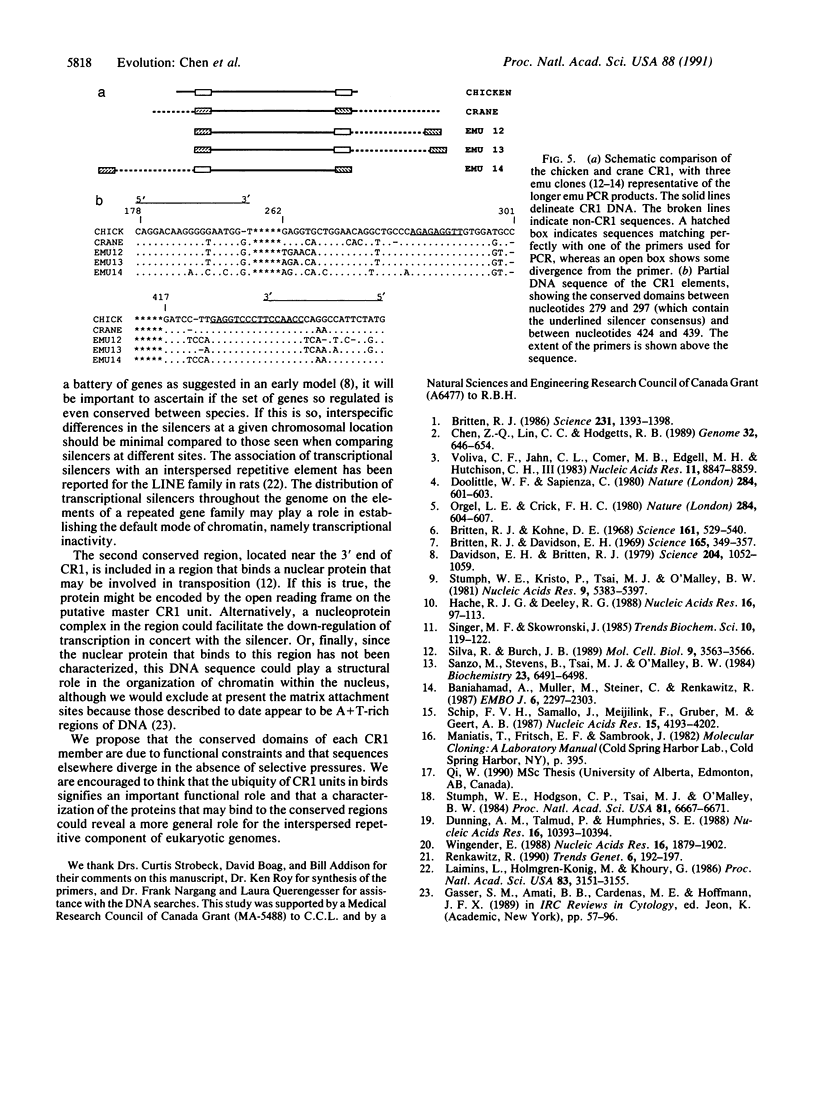
Images in this article
Selected References
These references are in PubMed. This may not be the complete list of references from this article.
- Baniahmad A., Muller M., Steiner C., Renkawitz R. Activity of two different silencer elements of the chicken lysozyme gene can be compensated by enhancer elements. EMBO J. 1987 Aug;6(8):2297–2303. doi: 10.1002/j.1460-2075.1987.tb02504.x. [DOI] [PMC free article] [PubMed] [Google Scholar]
- Britten R. J., Davidson E. H. Gene regulation for higher cells: a theory. Science. 1969 Jul 25;165(3891):349–357. doi: 10.1126/science.165.3891.349. [DOI] [PubMed] [Google Scholar]
- Britten R. J., Kohne D. E. Repeated sequences in DNA. Hundreds of thousands of copies of DNA sequences have been incorporated into the genomes of higher organisms. Science. 1968 Aug 9;161(3841):529–540. doi: 10.1126/science.161.3841.529. [DOI] [PubMed] [Google Scholar]
- Britten R. J. Rates of DNA sequence evolution differ between taxonomic groups. Science. 1986 Mar 21;231(4744):1393–1398. doi: 10.1126/science.3082006. [DOI] [PubMed] [Google Scholar]
- Chen Z. Q., Lin C. C., Hodgetts R. B. Cloning and characterization of a tandemly repeated DNA sequence in the crane family (Gruidae). Genome. 1989 Aug;32(4):646–654. doi: 10.1139/g89-493. [DOI] [PubMed] [Google Scholar]
- Davidson E. H., Britten R. J. Regulation of gene expression: possible role of repetitive sequences. Science. 1979 Jun 8;204(4397):1052–1059. doi: 10.1126/science.451548. [DOI] [PubMed] [Google Scholar]
- Doolittle W. F., Sapienza C. Selfish genes, the phenotype paradigm and genome evolution. Nature. 1980 Apr 17;284(5757):601–603. doi: 10.1038/284601a0. [DOI] [PubMed] [Google Scholar]
- Dunning A. M., Talmud P., Humphries S. E. Errors in the polymerase chain reaction. Nucleic Acids Res. 1988 Nov 11;16(21):10393–10393. doi: 10.1093/nar/16.21.10393. [DOI] [PMC free article] [PubMed] [Google Scholar]
- Haché R. J., Deeley R. G. Organization, sequence and nuclease hypersensitivity of repetitive elements flanking the chicken apoVLDLII gene: extended sequence similarity to elements flanking the chicken vitellogenin gene. Nucleic Acids Res. 1988 Jan 11;16(1):97–113. doi: 10.1093/nar/16.1.97. [DOI] [PMC free article] [PubMed] [Google Scholar]
- Laimins L., Holmgren-König M., Khoury G. Transcriptional "silencer" element in rat repetitive sequences associated with the rat insulin 1 gene locus. Proc Natl Acad Sci U S A. 1986 May;83(10):3151–3155. doi: 10.1073/pnas.83.10.3151. [DOI] [PMC free article] [PubMed] [Google Scholar]
- Orgel L. E., Crick F. H. Selfish DNA: the ultimate parasite. Nature. 1980 Apr 17;284(5757):604–607. doi: 10.1038/284604a0. [DOI] [PubMed] [Google Scholar]
- Renkawitz R. Transcriptional repression in eukaryotes. Trends Genet. 1990 Jun;6(6):192–197. doi: 10.1016/0168-9525(90)90176-7. [DOI] [PubMed] [Google Scholar]
- Sanzo M., Stevens B., Tsai M. J., O'Malley B. W. Isolation of a protein fraction that binds preferentially to chicken middle repetitive DNA. Biochemistry. 1984 Dec 18;23(26):6491–6498. doi: 10.1021/bi00321a034. [DOI] [PubMed] [Google Scholar]
- Silva R., Burch J. B. Evidence that chicken CR1 elements represent a novel family of retroposons. Mol Cell Biol. 1989 Aug;9(8):3563–3566. doi: 10.1128/mcb.9.8.3563. [DOI] [PMC free article] [PubMed] [Google Scholar]
- Stumph W. E., Hodgson C. P., Tsai M. J., O'Malley B. W. Genomic structure and possible retroviral origin of the chicken CR1 repetitive DNA sequence family. Proc Natl Acad Sci U S A. 1984 Nov;81(21):6667–6671. doi: 10.1073/pnas.81.21.6667. [DOI] [PMC free article] [PubMed] [Google Scholar]
- Stumph W. E., Kristo P., Tsai M. J., O'Malley B. W. A chicken middle-repetitive DNA sequence which shares homology with mammalian ubiquitous repeats. Nucleic Acids Res. 1981 Oct 24;9(20):5383–5397. doi: 10.1093/nar/9.20.5383. [DOI] [PMC free article] [PubMed] [Google Scholar]
- Voliva C. F., Jahn C. L., Comer M. B., Hutchison C. A., 3rd, Edgell M. H. The L1Md long interspersed repeat family in the mouse: almost all examples are truncated at one end. Nucleic Acids Res. 1983 Dec 20;11(24):8847–8859. doi: 10.1093/nar/11.24.8847. [DOI] [PMC free article] [PubMed] [Google Scholar]
- Wingender E. Compilation of transcription regulating proteins. Nucleic Acids Res. 1988 Mar 25;16(5):1879–1902. doi: 10.1093/nar/16.5.1879. [DOI] [PMC free article] [PubMed] [Google Scholar]
- van het Schip F., Samallo J., Meijlink F., Gruber M., AB G. A new repetitive element of the CR1 family downstream of the chicken vitellogenin gene. Nucleic Acids Res. 1987 May 26;15(10):4193–4202. doi: 10.1093/nar/15.10.4193. [DOI] [PMC free article] [PubMed] [Google Scholar]



